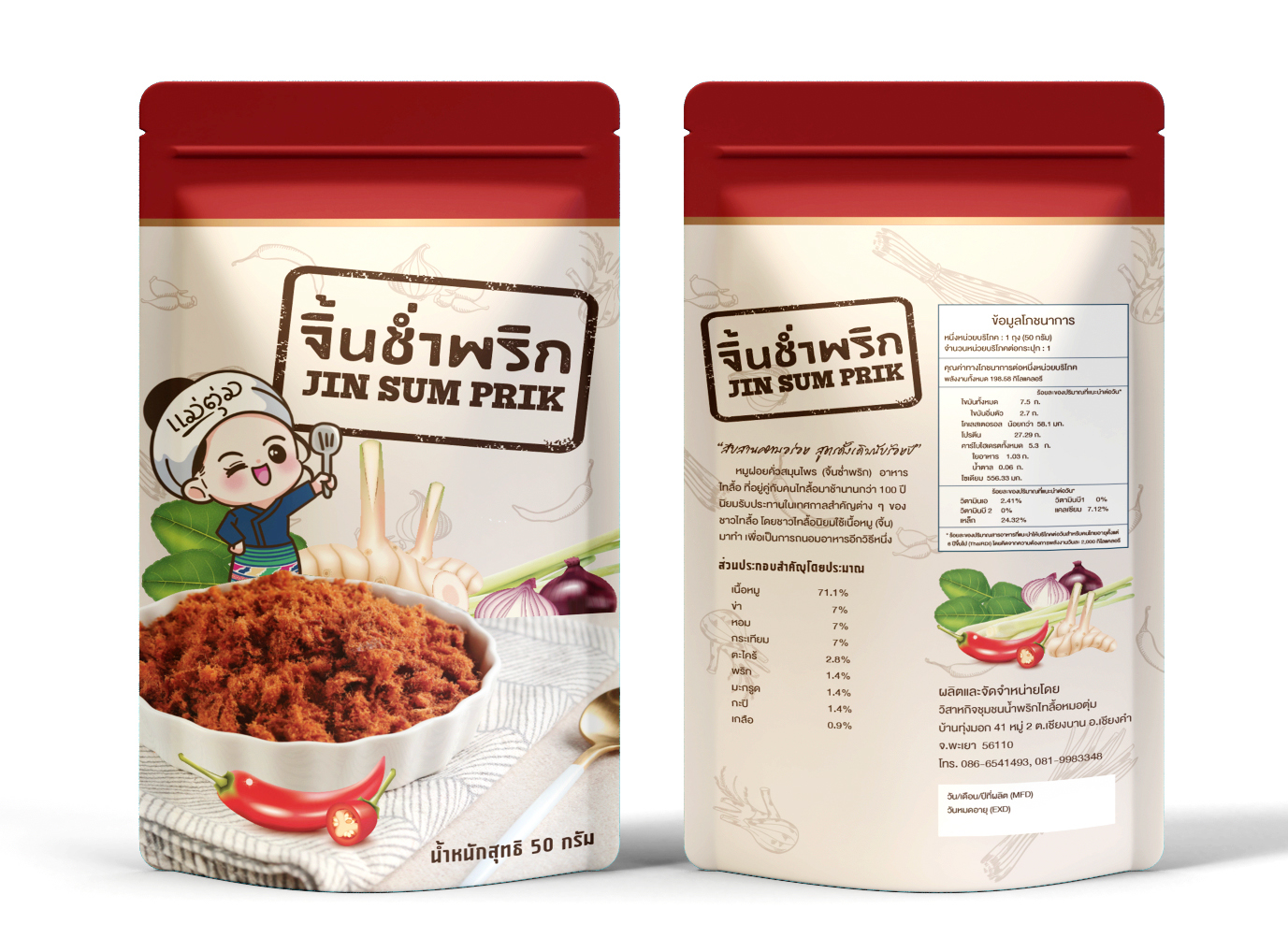Development of Jin Sam Prik Packaging to Increase the Revenue of Tai Lue Community, Phayao Province
Main Article Content
Abstract
Jin Sum Prik (shredded pork with herbs) is a local food of the Tai Lue community in Chiang Kham district, Phayao province. Jin Sum Prik originated from ancestral wisdom in food preservation, which involved processing pork and mixing it with local herbs, and it is a cultural food heritage that is at risk of being lost. Mae Tum Jin Sum Prik products in the Tai Lue community face a product development challenge as suitable and meet the local market demands. This research uses the participatory action research concept as follows: 1) analysis of product potential and target customers; 2) packaging development and distribution path creation; and 3) market testing. The research results in a new product design based on the origin of Jin Sum Prik, with a sticker design depicting a woman in a bun wearing Tai Lue traditional dress while holding a spatula to better convey the Thai Lue food identity. Also, the package design is modified into a zip-lock bag that specifies the ingredients and nutritional values. The development of this prototype packaging has three sizes. The 25 grams is at a selling price of 20 Baht per pack, the 30 grams is 35 Baht per pack with a promotion of three packs for 100 Baht, and 50 grams for 50 Baht. Additionally, marketing channels for the customer to access the products at consignment shops result in customers' familiarity and better recognition of these new packaging. In conclusion, the project has led to an average increase in sales from 2,000 Baht per month to 4,431.81 Baht per month.
Article Details

This work is licensed under a Creative Commons Attribution-NonCommercial-NoDerivatives 4.0 International License.
Area Based Development Research Journal values copyright protection and licensing to safeguard author rights and facilitate the appropriate dissemination of research. Our policies ensure openness, accessibility, and attribution. Authors retain copyright ownership, and articles are published under a Creative Commons Attribution License (CC BY), allowing sharing, adaptation, and proper attribution. Authors have the freedom to publish under the CC BY license, granting broad reuse and distribution permissions. The journal supports posting articles on third-party repositories, adhering to institutional and funding restrictions. Author guidelines detail copyright and licensing requirements, empowering authors with knowledge about their rights and responsibilities. These policies cultivate an environment of collaboration, openness, and responsible sharing, benefiting authors and the research community while honoring intellectual property rights.
References
Altay, B. C., Okumuş, A., & Adıgüzel Mercangöz, B. (2022). An intelligent approach for analyzing the impacts of the COVID-19 pandemic on marketing mix elements (7Ps) of the on-demand grocery delivery service. Complex & Intelligent Systems, 8(1), 129-140.
Ampansirirat, A. & Wongchaiya, P. (2017). The participatory action research: Key features and application in community. Journal of Humanities and Social Sciences Mahasarakham University, 36(6), 192-202. (in Thai).
Berman, B. (1996). Marketing Channels. New York: John Wiley & Sons. Bond, A., Palerm, J., & Haigh, P. (2004). Public participation in EIA of nuclear power plant decommissioning projects: A case study analysis. Environmental Impact Assessment Review, 24(6), 617-641.
Creighton, J. L. (2005). The public participation handbook: Making better decisions through citizen involvement. USA: John Wiley & Sons.
Cohen, J. M. & Uphoff, N. T. (1980). Rural development Participation: Concept and measures for project development committee center for international studies. USA: Cornell University.
Designated Areas for Sustainable Tourism Administration (Public Organization). (2018). Chiang Kham Tai Lue cultural tourist community. Retrieved December 6, 2022, from: https://cbtthailand.dasta.or.th/webapp/community/content/43/.
Dahlstrom, M. F. (2014). Using narratives and storytelling to communicate science with nonexpert audiences. Proceedings of the National Academy of Sciences of The United States Of America, 111(Suppl. 4), 13614–13620.
Green, S. J., Grorud-Colvert, K., & Mannix, H. (2018). Uniting science and stories: Perspectives on the value of storytelling for communicating science. Ottawa: Canadian Science Publishing.
Kaewthep, K. (2006). Characteristics and research for area-based. Chiang Mai: Wanida press. (in Thai).
Kitiburt, W. (2007). Development Thai Leau community products, Doi Saket district, Chiang Mai. (Research report). Chiang Mai: Chiang Mai Rajabhat University. (in Thai).
Martinez-Conde, S., & Macknik, S. L. (2017). Opinion: Finding the plot in science storytelling in hopes of enhancing science communication. Proceedings of the National Academy of Sciences, 114, 8127–8129.
Phayao Labor Office. (2022). Enhancing, protect, and quality of life of non-worker in Phayao provice. Retrieved March 6, 2022, from: https://phayao.mol.go.th/labor_statistics. (in Thai).
Piyachan, P., Pattaranukrom, P., Samukkethu, S., & Kamonsirisakul, H. (2020). System and mechanisms development to drive Community Based Research (CBR) in Bangkok. Romphruek Journal of Krirk University, 38(1), 51-66. (in Thai).
Prommanee, P. (2011). Storytelling technique. Retrieved January 6, 2022, from: https://www.gotoknow.org/ posts/456068. (in Thai).
Robiady, N. D., Windasari, N. A., & Nita, A. (2021). Customer engagement in online social crowdfunding: The influence of storytelling technique on donation performance. International Journal of Research in Marketing, 38(2), 492-500.
Rosenbloom, B. (1999). Marketing channels: A management view. Forth Wort: The Dryden Press.
Rowe, G., & Frewer, L. J. (2005). A typology of public engagement mechanisms. Science, Technology, & Human Values, 30(2), 251-290.
The Princess Maha Chakri Sirindhorn Anthropology Centre (public organization). (2022). Ethnic community: Chiang Kham Tai Lue (Chiang Kham district, Phayao province). Retrieved December 6, 2022, from: https://www.sac.or.th/databases/ethnic-groups/ethnicGroups/97. (in Thai).
Yanprateap, T. (2007). Non-fiction writing. 12th Edition. Bangkok: Ramkhamhang University Press. (in Thai).


